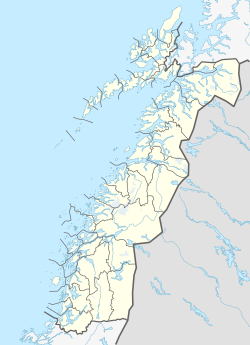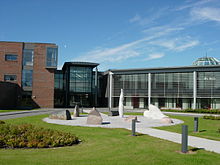
Nordland is one of the three northernmost counties in Norway in the Northern Norway region, bordering Troms in the north, Trøndelag in the south, Norrbotten County in Sweden to the east, Västerbotten County to the south-east, and the Atlantic Ocean to the west. The county was formerly known as Nordlandene amt. The county administration is in the town of Bodø. The remote Arctic island of Jan Mayen has been administered from Nordland since 1995. In the southern part of the county is Vega, listed on the UNESCO World Heritage Site list.

Bodø is a municipality in Nordland county, Norway. It is part of the traditional region of Salten. The administrative centre of the municipality is the town of Bodø. Some of the notable villages in Bodø include Misvær, Skjerstad, Saltstraumen, Løding, Løpsmarka, Kjerringøy, Sørvær, and Fenes.

Saltdal is a municipality in Nordland county, Norway. It is part of the traditional district of Salten. The administrative centre of the municipality is the village of Rognan. Other villages in Saltdal include Røkland and Lønsdal.

(Norwegian) or Fuossko (Lule Sami) is a municipality located in Nordland county, Norway. It is part of the traditional district of Salten. The administrative centre of the municipality is the town of Fauske. Some of the villages in Fauske include Nystad, Venset, Straumsnes, Sjønstå, Valnesfjord, Finneid, and Sulitjelma.

Sørfold is a municipality in Nordland county, Norway. It is part of the traditional district of Salten. The administrative centre of the municipality is the village of Straumen. Other villages in the municipality include Leirfjordgården, Mørsvikbotn, Røsvika, Rørstad, Styrkesvik, and Øvre Kvarv. The municipality surrounds the Sørfolda fjord and stretches east to the border with Sweden.

Mo i Rana is a city, and the administrative centre of the municipality of Rana, in Nordland county, Norway. It is located in the Helgeland region of Nordland, just south of the Arctic Circle. Some of the city's suburbs include Båsmoen and Ytteren in the north, Gruben in the south east, Selfors in the east, and Åga/Hauknes/Dalsgrenda in the south.

Trøndelag (Urban East Norwegian:[ˈtrœ̂ndəˌlɑːɡ]; or Trööndelage is a county and coextensive with the Trøndelag region in the central part of Norway. It was created in 1687, then named Trondhjem County ; in 1804 the county was split into Nord-Trøndelag and Sør-Trøndelag by the King of Denmark-Norway, and the counties were reunited in 2018 after a vote of the two counties in 2016.
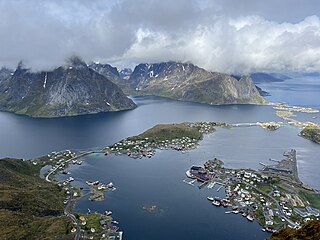
Lofoten, Lufoahtta (Lule Sami), or Lufuohttá (Northern Sami) is an archipelago and a traditional district in the county of Nordland, Norway. Lofoten has distinctive scenery with dramatic mountains and peaks, open sea and sheltered bays, beaches, and untouched lands. There are two towns, Svolvær and Leknes – the latter is approximately 169 km (105 mi) north of the Arctic Circle and approximately 2,420 km (1,500 mi) away from the North Pole. The archipelago experiences one of the world's largest elevated temperature anomalies relative to its high latitude.

Bodø Air Station is a military air base of the Royal Norwegian Air Force (RNoAF) located in the town of Bodø in Bodø Municipality, Nordland county, Norway. It is home to the General Dynamics F-16 Fighting Falcons of the 331 and 332 Squadrons and a detachment of Westland Sea King search and rescue (SAR) helicopters of the 330 Squadron. Air defense is provided using NASAMS and RBS 70, with the battalion based in Bodø Municipality. About 1,000 employees work at the air station, of which 450 are conscripts. Operations at the air station are organized as the 132nd Air Wing, which includes the Norwegian Joint Headquarters at Reitan and a detachment of Sea Kings at Station Group Banak. Bodø serves as the main air station for Northern Norway and shares its 3,394-meter (11,135 ft) runway with Bodø Airport.

Brønnøysund is a town and the administrative centre of Brønnøy Municipality in Nordland county, Norway. It is also a former municipality within Nordland county. The village of Brønnøysund originally was declared a ladested in 1923 which made it an independent municipality. After merging with Brønnøy in 1964, it lost its town status. Then in 2000, it once again received town status. The town lies along the coast and is often called "the coastal town in the middle of Norway." Brønnøysund is also the regional center of Southern Helgeland.

Aspmyra Stadion is a football stadium in the town of Bodø in Bodø Municipality in Nordland county, Norway. Home of Bodø/Glimt and Grand Bodø, it holds a seated capacity for 8,270 spectators. The venue has four stands: a modern all-seater with roof, 100 club seats and 15 luxury boxes to the south, unroofed all-seater stands to the east and west and two stands to the north. An older raised grandstand with roofing at the back and a new all-seater unroofed stand in front. Before this new stand was built the area in front of the old stand was a standing area that could hold approximately 2000 people, but did not fulfill UEFA safety regulations for international matches. The venue has floodlights and artificial turf with under-soil heating. Immediately south of the venue lies Aspmyra kunstgressbane, a training pitch with artificial turf. Aspmyra Stadion has hosted one Norway national football team match, against Iceland in 2002.
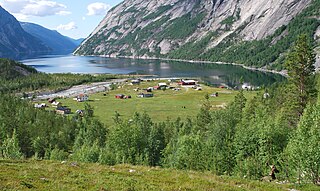
Northern Norway is a geographical region of Norway, consisting of the three northernmost counties Nordland, Troms and Finnmark, in total about 35% of the Norwegian mainland. Some of the largest towns in Northern Norway are Mo i Rana, Bodø, Narvik, Harstad, Tromsø and Alta. Northern Norway is often described as the land of the midnight sun and the land of the northern lights. Farther north, halfway to the North Pole, is the Arctic archipelago of Svalbard, traditionally not regarded as part of Northern Norway.

is a town in Nord-Aurdal Municipality in Innlandet county, Norway. The town is the administrative centre of the municipality as well as the largest urban/commercial centre for the Valdres region. It is located just northwest of the village of Leira and about 5 kilometres (3.1 mi) south of the village of Skrautvål. The 2-square-kilometre (490-acre) town has a population (2021) of 1,951 and a population density of 978 inhabitants per square kilometre (2,530/sq mi).
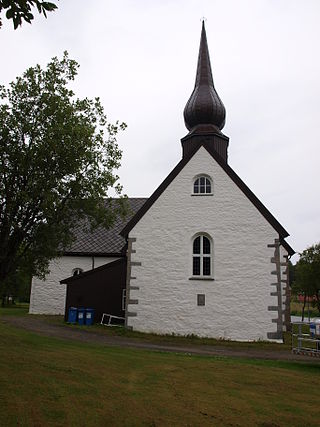
Bodin is a former municipality in Nordland county, Norway. The 910-square-kilometre (350 sq mi) municipality existed from 1838 until its dissolution in 1968. The area is now part of Bodø Municipality in the traditional district of Salten. The administrative centre was located in the town of Bodø which actually was not part of Bodin Municipality. Notable villages in Bodin included Løding, Fenes, and Løpsmarka.

Bardufoss Airport is a primary airport situated at Bardufoss in Målselv Municipality in Troms county, Norway. The airport, which is the civilian sector of the Royal Norwegian Air Force's (RNoAF) Bardufoss Air Station, is operated by the state-owned Avinor. It consists of a 2,443-meter (8,015 ft) runway, a parallel taxiway and handled 218,451 passengers in 2014. Norwegian Air Shuttle (Norwegian) operates three daily flights with Boeing 737s to Oslo. The airport's catchment area covers central Troms.

Salten Kraftsamband or SKS is a Norwegian power company that operates eight hydroelectric power stations with annual production of 1,770 GWh. Since 1997 the company has also sold power to end-users. Head offices are located in Fauske.

City Nord is a shopping center located at Stormyra in the town of Bodø in Bodø Municipality, Nordland county, Norway. Measuring 40,000 square meters (430,000 sq ft) and with more than 100 stores, it is the largest shopping center in Northern Norway. The shopping center opened in 1994 and has been expanded several times, first in 2008. The center suffered minor damage in a fire in December 2008.

Skjerstad is a former municipality in Nordland county, Norway. The 465-square-kilometre (180 sq mi) municipality existed from 1838 until its dissolution in 2005. The area is now part of Bodø Municipality in the traditional district of Salten. The administrative centre was the village of Misvær. Another village in the municipality was the village of Skjerstad where Skjerstad Church was located. The municipality generally encompassed the area around the Misværfjorden, although it originally was much larger, also including the entire present-day Fauske Municipality.
Rolf Fredrik "Truls" Klausen is a Norwegian former professional footballer who played as defender. After starting his career with Frigg Oslo and Vålerenga Fotball in the early 1970s, he spent most of his career, from 1975 to 1984, at FK Bodø/Glimt, who won the 1975 Norwegian Football Cup in his first season and were promoted the following season to Eliteserien. He was team captain from 1981 and subsequently worked with the team as a coach and physiotherapist.


